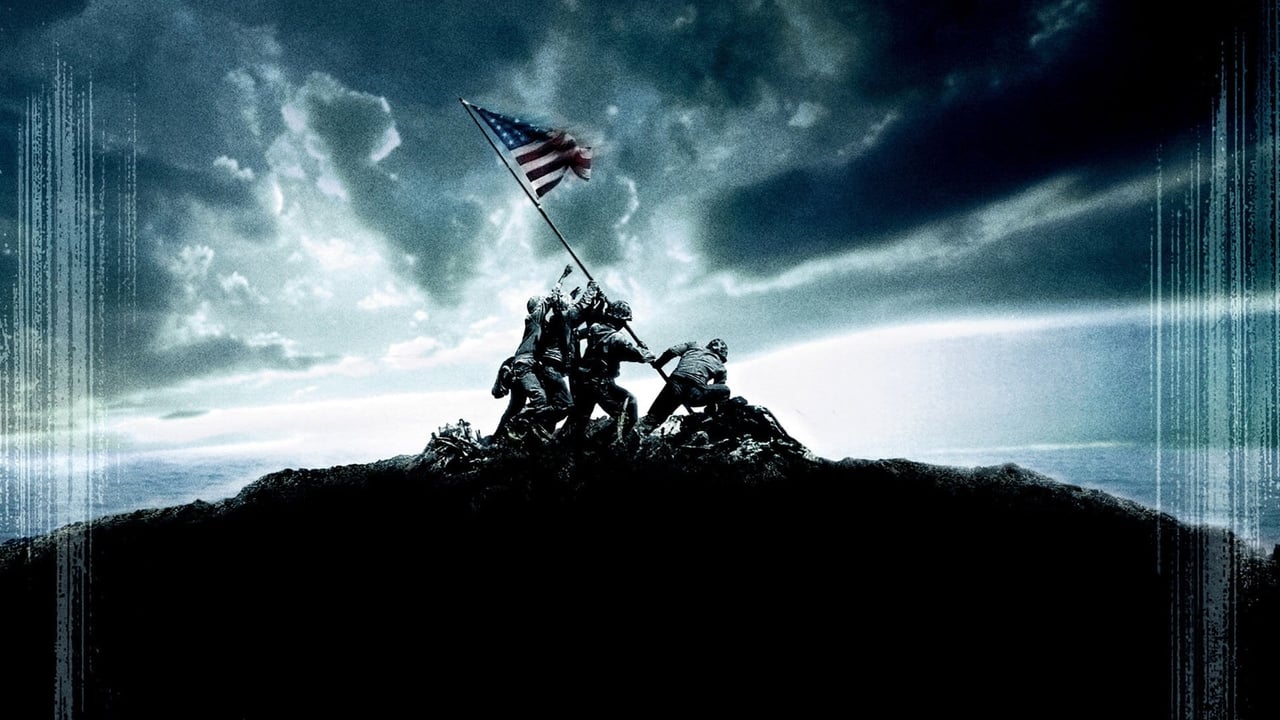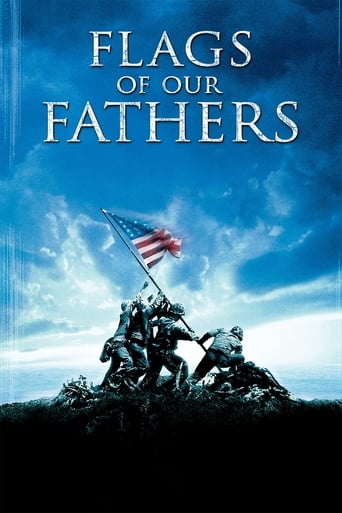

Am i the only one who thinks........Average?
... View MoreAbsolutely amazing
... View MoreThe film makes a home in your brain and the only cure is to see it again.
... View MoreTrue to its essence, the characters remain on the same line and manage to entertain the viewer, each highlighting their own distinctive qualities or touches.
... View MoreIn his review of "Letters from Iwo Jima", Roger Ebert recalled the line from "Patton"'s iconic monologue, you don't win a war by dying for your country but by making "the other poor dumb bastard die for his country", maybe that's why the Americans won the war after all, they fought to death. Japanese, while honorably, fought to their death, too.And "Flags of Our Fathers", first opus of Clint Eastwood's "Iwo Jima" duology also reminded me of a quote from the same monologue: "an army is a team - it lives, eats, sleeps, fights as a team. This individuality stuff is a bunch of crap." And as far as exemplifying the team spirit within the army, the famous picture of the flag-raising over Mount Suribashi is quite an eloquent illustration.It is indeed one of the most iconic, parodied and probably misundestood pictures of all time, taken at face value and wrongly translated as the epitome of victory while the battle, one of the toughest and deadliest of WW2, was still going on and half of the soldiers in the picture would eventually die. Interestingly, we never see their faces and for a few of them their bodies, but that's what makes it such a great symbol of anonymous heroism carried by a group, not individuals.In other words, it shouldn't have mattered who raised the flag, and I guess it didn't, what mattered is that it was the American flag and that sight was enough to awaken the Americans from lassitude and convince them to buy bonds. So the American government couldn't rely on a simple photograph, and needed the three survivors to play the game as ambassadors from that moment that stopped belonging to them, but to history, transiting though with politics. Clint Eastwood's adaptations of James Bradley's novel, takes us, in a fascinating introspection into the various perceptions of heroism depending on the perspectives. Even in Eastwood movies I disliked like "Unforgiven" and "American Sniper", I respected morally ambiguous characters for some values they carried and that I could relate to. Here I expected a new "Saving Private Ryan", but Spielberg is "only" the producer, Eastwood isn't the preacher type (not always anyway) and the flag isn't the end, but the beginning.And for the survivors, the beginning of an odd journey. Harlon Block (Benjamin Walker) and Sergeant Michael Strank (Barry Pepper) were all dead and as soon as the survivors were identified, they're taken for a long ride across America to encourage cheerful crowds to buy war bonds. The film unveil many aspects of their lives and how it affected their reactions. The father of the novel's author, Pharmacist "Doc" Bradley (Ryan Phillippe) is good-hearted and altruistic, he comforted his dying comrades and takes his new assignment as a way to comfort the spirits of people. Rene Gagnon (Jesse Bradford) sort of enjoys his new fame and the attention it brings (so does his girlfriend) but insists that he was just lucky, as they all say, the real heroes didn't come back. The most tragic character and the soul of the film is Ira Hayes (Adam Beach in a performance that should have earned him a few nods), his experience doesn't differ from the rest of the soldiers except that he's of Native background, an outcast status that pushed him to keep a low profile which was perfect for the army body. Being propelled in the main front, not to fight but to pose as a clean-cut hero could only make things worse to him, especially when he's still victim of racist paternalism or plain segregation. Hayes' tragedy is that he's not concerned by politics but politics were concerned by him.The film is punctuated with many war flashbacks that show the incredible gap between the atrocities in the island and the whole backstage show, the most infamous episode is Ralph "Iggy" Ignatowky (Jamie Bell) whose death is only alluded but a glimpse on a Wikipedia page will tell you that some soldiers' blood drop more significantly than other on the sand of Iwo Jima. Violence reached such a paroxysm that there was no possible way for the soldiers to recover unless they decided to keep quiet about it, about the details anyway. And yet the three survivors had to talk, talk and talk.They were even forced to replicate the deed over a mountain made of carton during a big exhibition in a stadium with the typical American fireworks, cheerleaders and all that jazz their supervisor prepared. The pseudo-flag-raising intercut with scenes of extreme violence, showing the deaths of the other soldiers, create a difficult mood whiplash but it's crucial in the understanding of another sad aspect about war, you must pretend.. These guys must act as heroes because the war needed them to be heroes, even the picture while speaking a thousand words, didn't say that it was the second flag raising, causing one of the soldiers to be misidentified, although his mother could, even from behind.The film reveals many secrets about the iconic shot, a lucky one from a photographical perspective and it also reminded me of Jean Gabin's speech in "The President", addressing a parliament member parliament too young to have fought in WW1, he said "you talk about millions but as a guy in the trenches, I can only remember a dozen of deaths, scope differs whether you're in or out the front", indeed.For the politician, it's about the big picture. For soldiers, it's just about kill and not to be killed, and protecting or saving your buddies. The tragedy is more intimate and it follows the 'privileged' ones for the rest of their lives... that's heroic enough to me. And the picture reminded of this adage: when a man points to the moon, the fool sees his finger. The government looked at for the American flag, but Eastwood is pointing to the guys who raised it.
... View MoreThis is a movie that turns a story about how the government and media join together to manipulate facts for political and economic purposes into schmaltz. Everything about this movie is pure Hollywood, from the corny and hokey portrayals of the characters, reducing real-life heroes into caricatures, to the stagy acting, the phony theatrics, and the unbelievably simplistic depiction of President Roosevelt. The movie inspires not one iota of feeling of drama, including the battle scenes that are little more than computer graphics in back of a sound stage. If the intent of this movie was to make a political point, or any point, that message is at best blunted. The flag-raising scenes are glossed over, the the first one is barely mentioned, and the assertion that the US was ready to sue for peace because the country was low on funds is grotesque. The Battle of Iwo Jima is one of the iconic battles of history. The American troops demonstrated a level of valor that the movie fails to convey. True, Americans are shown being involved in battle, but these scenes are so obviously staged that they lose their dramatic impact. Over six thousand Americans died on Iwo Jima and many thousands more were injured. The Japanese garrison defending the island was practically obliterated. It is probably impossible to make a movie that can adequately rcreate the intensity of the fighting. This movie tries to do that and fails, not because they omit scenes of battle, but because the battle itself is reduced to a backdrop for a story that has to do more with politics than war. That the second flag raising got play while the first flag waving was ignored is perhaps an injustice. But to take that and make it the central theme of the story is almost sad because there was so much more that the movie could of depicted, and did not.
... View MoreIn 1945, the picture of the flag raising on Mount Suribachi on Iwo Jima becomes an immediate icon. The six soldiers in the picture become instant celebrity heroes. Three of them are brought back to the states to sell Bonds. Corpsman John 'Doc' Bradley (Ryan Phillippe) continues to be haunted for the rest of his life. He and others Rene Gagnon (Jesse Bradford), Hank Hansen (Paul Walker), Mike Strank (Barry Pepper), Ira Hayes (Adam Beach) and Franklin Sousley (Joseph Cross) train together and sent into Iwo Jima. They are led by Captain Severance (Neal McDonough). Rene Gagnon tells the brass that Ira Hayes was one of the flag raiser which truly angers him and which he denies. Keyes Beech (John Benjamin Hickey) and Bud Gerber (John Slattery) push the tour selling the picture and War Bonds. There is confusion about the two flags and controversy over who the true people in the picture. It's a darker compelling telling of the battle and its aftermath. It starts moody and even the battle isn't as heroic as expected. A man falls overboard and no ship stops to save him. The battle is ugly and bloody. There is a greyness to the battle that makes it almost black and white. The confusion adds depth to the characters and the reactions add substance. The fascinating thing about this is that their odyssey doesn't end after the battle. This is also a movie about the human condition. Adam Beach is especially good in a juicy role struggling with guilt and pride.
... View MoreRecently, war movies have aroused great interest. Accordingly, a plethora of this sort of movies has invaded our cinemas. Maybe the two most popular war movies in recent years have been Saving Private Ryan, directed by Steven Spielberg, focused on the Normandy Landings, and Flags of our Fathers, directed by Clint Eastwood, focused on the battle of Iwo Jima (together with Letters from Iwo Jima, the Japanese view of the conflict, whose premiere in Spain will be held in few weeks). Both films show bloody scenes of fights and, as a result, the cruelty of the war. In addition, a large part of both films is focused on the miseries and attitudes towards death, danger and desperation of a small group of soldiers. Also common to both films is the fact that the main characters are actually antiheroes. The Spielberg's film takes place mostly in the battlefield and is perfectly linear. On the other hand, flashbacks are used in Flags of our Fathers in order to show both the war and the propaganda campaign undertaken by the main characters going across the United States. By virtue of this we can see a different drama in this film related to the feelings and problems of the soldiers when they come back home to undertake a mission they have not been trained for. Furthermore, we clearly identify with the leading actor in Saving Private Ryan (Tom Hanks). On the contrary, the three actors in Eastwood's film actually share the prominence. The strength of Saving Private Ryan lies in the intense representation of the war and it is a typical war film, maybe better than others, but a war film nevertheless. However, Flags of our Fathers is more complex. With his usual skill, Eastwood shows a combination of war and politics, death and propaganda.
... View More